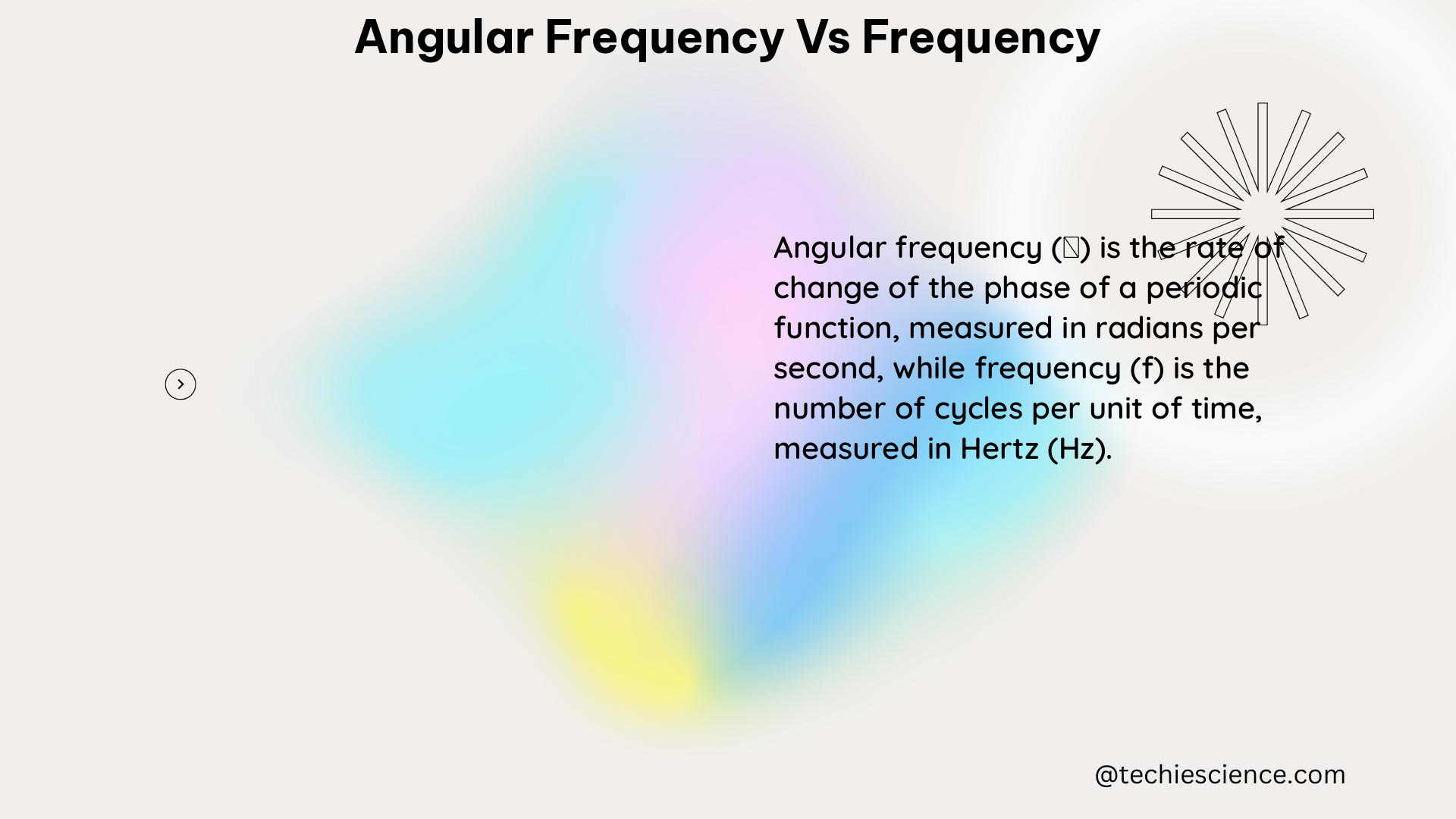Summary
Angular frequency and frequency are both measures of the rate of repetitive events, but they differ in their units and applications. Angular frequency, denoted by ω, is measured in radians per second (rad/s) and represents the rate of change of the phase angle of a periodic function. Frequency, denoted by f, is measured in cycles or oscillations per second (Hz) and represents the number of complete cycles or oscillations per unit time. The relationship between angular frequency and frequency is given by the equation ω = 2πf, which is crucial in understanding the dynamics of various physical systems.
Understanding Angular Frequency

Angular frequency, ω, is a fundamental concept in classical mechanics and wave mechanics. It represents the rate of change of the phase angle of a periodic function, such as an oscillation or a wave. The phase angle is the angle between the current position of the periodic function and its initial position.
Characteristics of Angular Frequency
- Measured in radians per second (rad/s)
- Represents the ‘speed’ or rate of change of a periodic function
- Significant in understanding the dynamics of oscillating systems and wave propagation
- Closely related to the period (T) of the periodic function through the equation ω = 2π/T
Calculating Angular Frequency
The angular frequency of a system can be calculated using various formulas, depending on the specific physical situation. Some common examples include:
- Simple Harmonic Motion:
- For a mass-spring system, the angular frequency is given by ω = √(k/m), where k is the spring constant and m is the mass.
-
Example: For a mass-spring system with k = 1.2 N/m and m = 0.4 kg, the angular frequency is ω = √(1.2/0.4) = 1.7 rad/s.
-
Electromagnetic Waves:
- The angular frequency of an electromagnetic wave is used in the temporal part of the wave function, indicating the rate of change of the wave’s phase angle.
- Example: The angular frequency of a radio wave with a frequency of 100 MHz is ω = 2πf = 2π × 100 × 10^6 = 6.28 × 10^8 rad/s.
Understanding Frequency
Frequency, f, is a measure of the number of complete cycles or oscillations per unit time. It is commonly used to describe the repetition rate of events, such as the number of times a pendulum swings per second or the number of cycles per second in an electrical signal.
Characteristics of Frequency
- Measured in cycles or oscillations per second (Hz)
- Represents the number of complete cycles or oscillations per unit time
- Commonly used to describe the repetition rate of events
- Closely related to the period (T) of the periodic function through the equation f = 1/T
Calculating Frequency
The frequency of a periodic function can be calculated using the following formula:
f = 1/T
Where T is the period of the periodic function, which represents the time taken for one complete cycle or oscillation.
Example:
– A pendulum oscillates with a period of 0.5 seconds.
– The frequency of the pendulum is f = 1/T = 1/0.5 = 2 Hz.
Relationship Between Angular Frequency and Frequency
The relationship between angular frequency and frequency is given by the equation:
ω = 2πf
This equation indicates that angular frequency is equal to 2π times the frequency. This means that if the frequency increases, the angular frequency also increases, and vice versa.
Numerical Examples
- Pendulum Oscillation:
- A pendulum oscillates at a frequency of 2 Hz.
-
The angular frequency of the pendulum is ω = 2πf = 2π × 2 = 4π rad/s.
-
Spring-Mass System:
- A spring-mass system has a spring constant of 5 N/m and a mass of 20 kg.
- The angular frequency of the system is ω = √(k/m) = √(5/20) = 0.5 rad/s.
Theorems and Physics Formulas
- ω = 2πf (Relationship between angular frequency and frequency)
- ω = √(k/m) (Angular frequency of a mass-spring system)
- T = 1/f (Relationship between period and frequency)
- ω = 2π/T (Relationship between angular frequency and period)
Figures and Data Points
- Angular frequency is measured in radians per second (rad/s)
- Frequency is measured in cycles or oscillations per second (Hz)
- The period of an oscillation is the reciprocal of the frequency: T = 1/f
- The angular frequency and period are related by: ω = 2π/T
Reference Links
- https://www.vaia.com/en-us/explanations/physics/classical-mechanics/angular-frequency-and-period/
- https://www.physicsforums.com/threads/the-difference-between-angular-frequency-and-frequency.938722/
- https://www.quora.com/What-is-the-difference-between-angular-frequency-and-frequency-with-example
Hi,
I am Rabiya Khalid, I have completed my masters in Mathematics. Article writing is my passion and I have been professionally writing for more than a year now. Being a science student, I have a knack for reading and writing about science and everything related to it.
In my free time, I let out my creative side on a canvas.